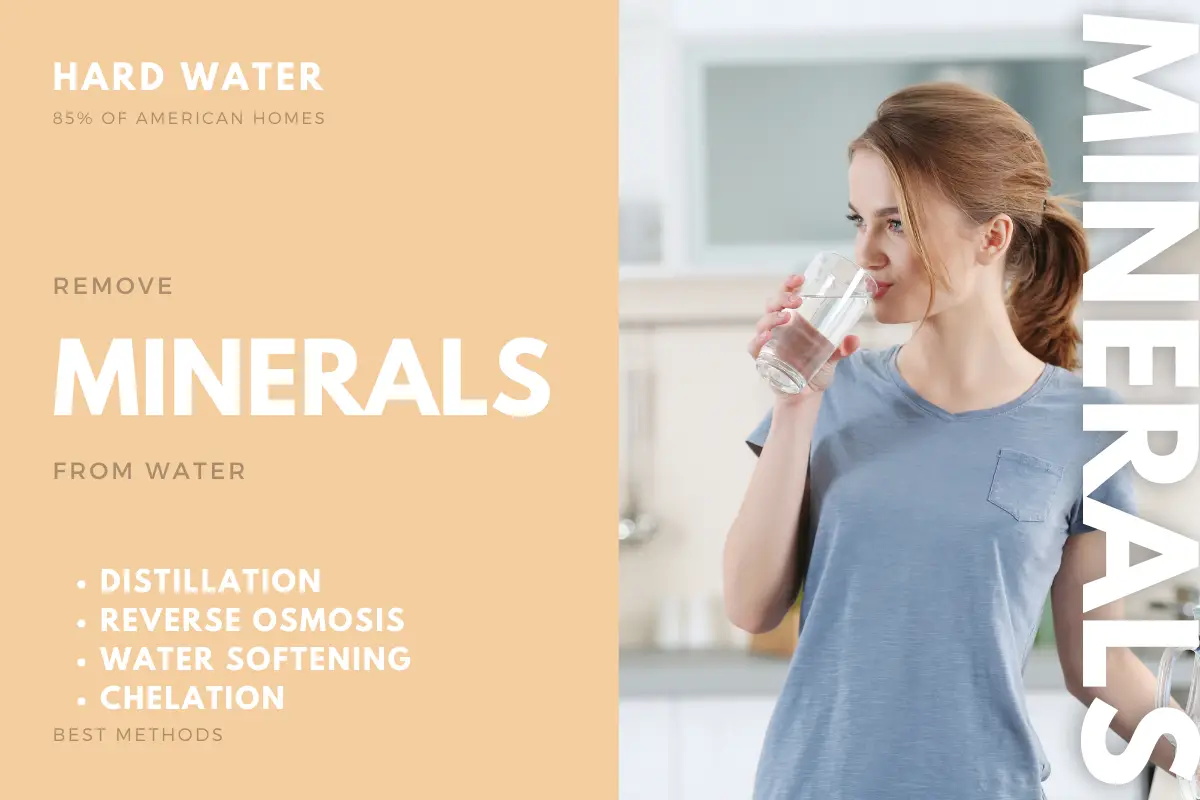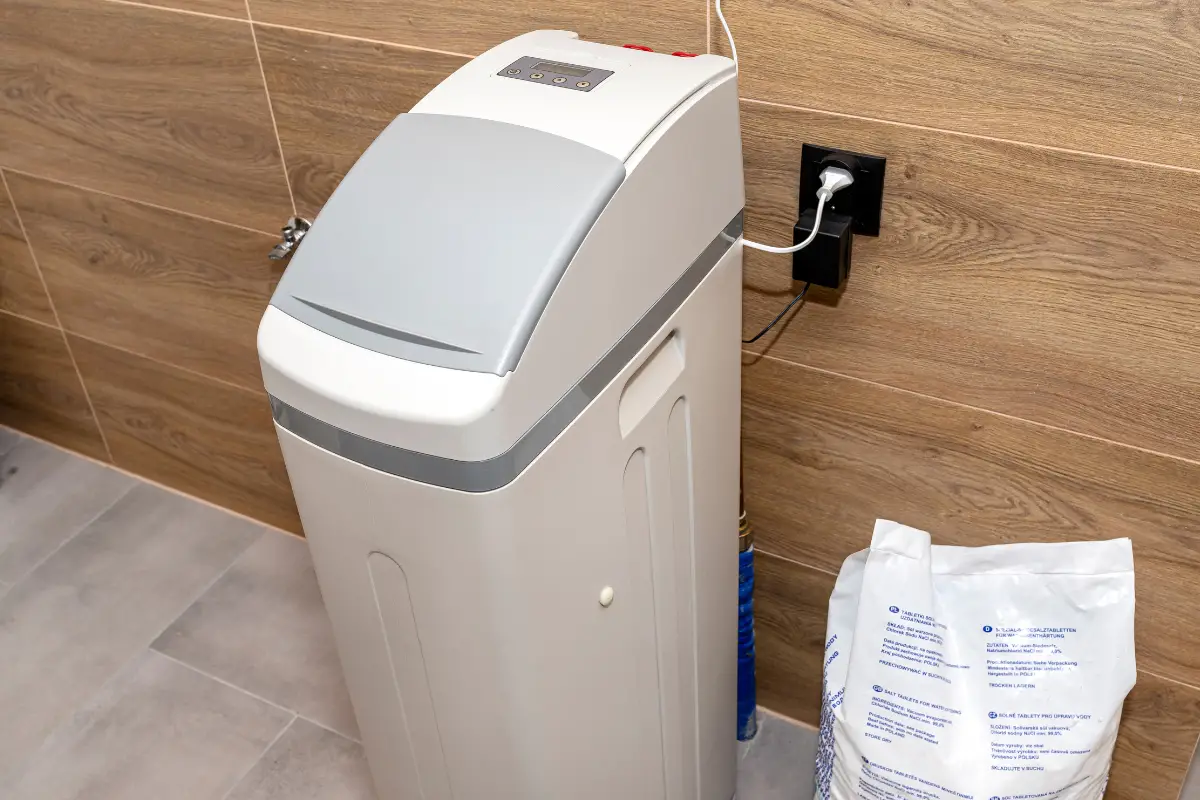Water naturally contains different minerals dissolved in it, depending on the water source. These minerals are often not dangerous, but you may want them out of your water for one reason or another.
Minerals can be removed from water by distillation, reverse osmosis, water softeners, and chelation. Distillation and reverse osmosis remove all minerals from water. Water softening and chelation primarily remove hardness minerals like calcium and magnesium.
In this article, we will discuss these different ways of removing minerals from water, which type of water has all its minerals removed, and if you actually need minerals in your drinking water.
Ways to Remove Minerals from Your Water

Water from various natural sources contains different dissolved minerals, including potassium, calcium, fluoride, chlorine, iron, magnesium, sodium, sulfate, bicarbonate, and phosphorus.
Some of the most common minerals in tap water are calcium, magnesium, and sodium.
These minerals are typically not harmful and are usually beneficial to your health, but only when they are in the right quantities.
Sometimes, these minerals are present in concentrations that are too high and may affect your health, plumbing fixtures, appliances, and even clothes.
Minerals such as calcium and magnesium cause water hardness. 85% of American homes have hard water, and this may cause damage to skin, hair, clothes, plumbing fixtures, etc.
Whether you want to remove hardness minerals like calcium and magnesium alone or you want all minerals out of your water, there are a couple of methods you can use.
The best methods include:
1. Distillation

Distillation is one water purification method that can remove all minerals from water, producing completely pure water.
This method can remove virtually all dissolved solids and minerals, including hardness minerals like calcium and magnesium.
Distillation purifies water by heating, evaporation, and condensation. Water is added to the boiling tank of a distillation unit and boiled until it evaporates.
The water vapor enters a separate compartment where it is cooled and condenses.
The water molecules evaporate at a lower temperature than the dissolved minerals like calcium and magnesium.
Because they cannot be converted into vapor at the same temperature as water, the contaminants and minerals are left behind in the boiling chamber when water evaporates.
As a result, when the water vapor condenses, the water formed is completely free from minerals and other impurities.
2. Reverse Osmosis

This is another type of water purification system that can remove all minerals and contaminants in water, producing pure water.
The reverse osmosis system will remove 90-99% of all contaminants and minerals in water, including microbes, salt, manganese, chlorine, iron, fluoride, lead, and calcium.
They can also remove heavy metals, chemicals, and even prescription drugs that have been disposed of improperly.
Reverse osmosis uses the membrane separation method. This method passes pressurized water through a semi-permeable membrane.
This membrane has tiny pores that allow water molecules to pass but hinder other substances.
Because dissolved minerals have larger molecules than water, these substances are trapped by the membrane while water flows through.
RO water is sometimes called ‘dead water’ because it is free from contaminants and minerals. Reverse osmosis has the advantage of both filtration and demineralization of water.
Hard water can cause damage to the RO filtration system. To avoid this, a water softener should be used as a pretreatment for water before it is filtered through a RO system.
If the membrane gets damaged, minerals and contaminants can leak through into the filtered water.
The RO semi-permeable membrane needs good maintenance and regular checks. Most need replacement every 1-2 years to keep the reverse osmosis system functioning properly.
3. Water Softener

A water softener removes dissolved minerals like calcium and magnesium from your water. Calcium and magnesium are responsible for the hardness of water.
A water softening system works by exchanging these minerals for sodium or potassium ions through a process known as ion exchange. It is one of the most effective softening techniques.
Ion exchange uses a resin media bed that contains specially manufactured beads with high sodium content.
These beads have electric charges, and as hard water passes through, the electric charge attracts and binds the mineral ions, which are also charged molecules.
The calcium and magnesium ions are trapped in the resin and then replaced by sodium or potassium ions.
This exchange makes the water a bit salty, but the saltiness mostly goes unnoticed because the ion exchange occurs on a minute scale. The sodium added is minimal.
Water softening helps prevents the formation of scale deposits in your appliances. These salt-based water softeners are cheap to run after installation.
They usually last for many years. You only need to refill the salt in the tank when it is low. They are also the most efficient water-softening systems for hard water problems.
If you’re on a strict low-salt or sodium-restricted diet, potassium salt is a good alternative for the ion exchange process.
To install a water softener system yourself, you need good plumbing knowledge and experience. If you don’t have any, you may want to call a professional to install the system.
4. Chelation
It involves the use of a chelant to treat the water supply. A chelant is a molecule that binds to metal ions like calcium, magnesium, iron, and manganese, preventing them from forming deposits on surfaces.
These molecules don’t exactly remove hard water minerals, they just prevent scale deposits from forming by keeping the minerals suspended in water.
Because it doesn’t remove the minerals from water, chelation is not as effective as ion exchange in water softening. However, it is a good option for strict low-sodium diets.
What Water Has All Minerals Removed?
Distilled water is a type of purified water with all its minerals removed. The process of distillation is a thorough and very effective water purification method.
Distilled water contains just the hydrogen and oxygen of water. As a result, you may find that it has a flat taste.
Do You Really Need Minerals In Water?
Minerals dissolved in water provide several health benefits to the body.
Often, public water supplies even add specific minerals to water to reduce the likelihood of people being affected by mineral deficiencies.
A good example of this is water fluoridation, a process where fluoride is added to water supplies. This practice is common in the United States and has been in existence for over 70 years.
Water fluoridation has had significant benefits to the health of Americans – particularly dental health.
It has drastically reduced the occurrence of dental caries and tooth decay in both children and adults.
However, minerals dissolved in water can be problematic, especially when they are present in overly high concentrations.
A good example is hard water which contains high amounts of calcium and magnesium that can pose a problem to your plumbing and appliances.
Minerals in water also have the added benefit of improving the taste and feel of water.
Water is a good source of minerals our bodies require.
However, these minerals can also be gotten from other sources, especially from our food and dietary supplements.
As long as you’re getting the minerals from your diet daily, you don’t necessarily need them in your drinking water.

